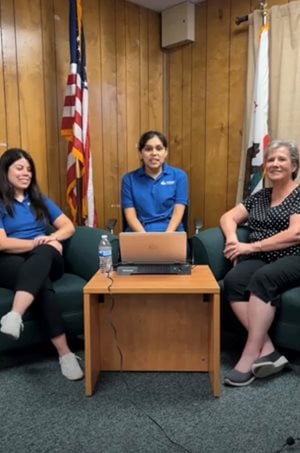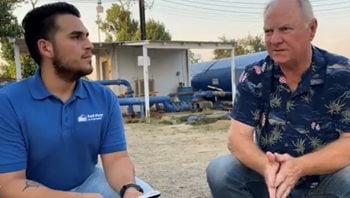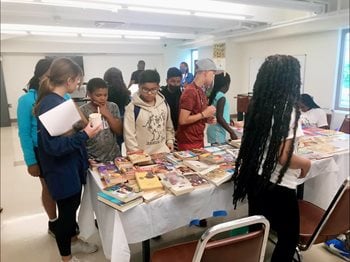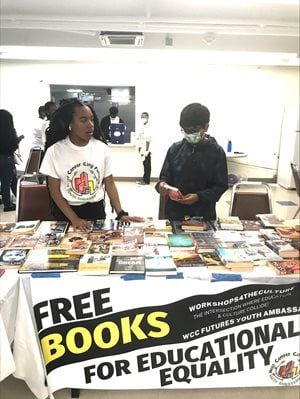Even at a distance, residents find ways to work together. During the pandemic, NeighborWorks network organizations continued to generate ideas through NeighborWorks America's Community Leadership Institute (CLI), and continued to find ways to improve their communities. Some in-person projects stayed in-person once restrictions on gathering together in groups eased. Other projects went virtual, like a course at Self-Help Enterprises that focused on discussions around potable water.
As NeighborWorks network organizations travel with teams of resident leaders to Charlotte, North Carolina, for the first in-person leadership institute since 2019, staff and resident leaders recall some projects that help make communities places of opportunity.
"Some residents come into the CLI with ideas," says Sarah Parmenter, NeighborWorks America's director of Community Building and Engagement. "Other ideas are born there. But one of the biggest things that comes out of the CLI is the change in the residents themselves."
Parmenter says NeighborWorks has long been dedicated to supporting resident leaders. It's part of NeighborWorks' roots with Dorothy Mae Richardson, who galvanized her Pittsburgh neighbors in the 1960s, saving their homes and neighborhood.
"Residents know their communities best and know, first-hand, the changes that would make those communities better," Parmenter explains. That may mean clean-up of a lot or planting a community garden. It may mean a new class or collecting the oral history of a neighborhood. "There are so many possibilities and residents see those possibilities and make them realities."
Residents often stay involved long after a project has ended, too, Parmenter says. And they inspire their friends and families to get involved.
Taking it online
 Eva Dominguez, a manager at Self-Help Enterprises, says that originally, her group had planned to bring community members on a bus tour to learn more about different methods to bring potable water to residents. "Because of COVID, we couldn't do the tour," she says. "Our leadership group had to think of a different way."
Eva Dominguez, a manager at Self-Help Enterprises, says that originally, her group had planned to bring community members on a bus tour to learn more about different methods to bring potable water to residents. "Because of COVID, we couldn't do the tour," she says. "Our leadership group had to think of a different way." They ended up conducting interviews and broadcasting them on Facebook Live so community members could engage safely and virtually. The videos remain as an online resource.
"The leadership group came up with the questions and talked about what they wanted to see," she says. "They picked the topics and our staff drove around to do the interviews. We wanted to try something that would still meet our goals."
The leadership group focused on water issues because water has long been an issue for the region around Visalia, California, and Self-Help has long assisted rural communities in identifying sources of clean drinking water and developing sanitary sewer systems. Topics ranged from water treatment to private, domestic wells. Some of the interviews were conducted in Spanish.
clean drinking water and developing sanitary sewer systems. Topics ranged from water treatment to private, domestic wells. Some of the interviews were conducted in Spanish.
 clean drinking water and developing sanitary sewer systems. Topics ranged from water treatment to private, domestic wells. Some of the interviews were conducted in Spanish.
clean drinking water and developing sanitary sewer systems. Topics ranged from water treatment to private, domestic wells. Some of the interviews were conducted in Spanish. "It was important for all of the community to be involved," Dominguez says. "We wanted people to have more information about where their water comes from, why tap water is safe – and what happens when it's not. We have a lot of small rural communities who have faced the same issues in the past, so it helps to share ideas for solutions."
By the book
CaDeidra Jarmon, coordinator of Community Building and Engagement for Interfaith Community Housing in Delaware, attended the virtual CLI with her team in 2021. That year, they needed a project  that could work well while social distancing, so the group focused on the learning gap that many families had experienced during the pandemic, with a specific goal: They would collect books that reflected the community. That meant books by Black or Brown authors, Jarmon says. They collected both books for young people and books for adults, and collected the first batch on Martin Luther King Jr. Day.
that could work well while social distancing, so the group focused on the learning gap that many families had experienced during the pandemic, with a specific goal: They would collect books that reflected the community. That meant books by Black or Brown authors, Jarmon says. They collected both books for young people and books for adults, and collected the first batch on Martin Luther King Jr. Day.
 that could work well while social distancing, so the group focused on the learning gap that many families had experienced during the pandemic, with a specific goal: They would collect books that reflected the community. That meant books by Black or Brown authors, Jarmon says. They collected both books for young people and books for adults, and collected the first batch on Martin Luther King Jr. Day.
that could work well while social distancing, so the group focused on the learning gap that many families had experienced during the pandemic, with a specific goal: They would collect books that reflected the community. That meant books by Black or Brown authors, Jarmon says. They collected both books for young people and books for adults, and collected the first batch on Martin Luther King Jr. Day. "We asked the surrounding community, schools, teachers and more," Jarmon says. "We knew a lot of people would want to give back to the community."
They received hundreds of books and did both giveaways and readings. They also made the books available for their summer youth ambassador program, where students organized the books and made them available to residents. The project is ongoing.
Jarmon says that the CLI – whether in person or virtual – "helps bring us together, giving us sessions that take us in the right direction. With the CLI and NeighborWorks backing us and giving us so many supports, our residents and CLI team feels supported and excited to do the work."

Nnamdi Chuckawa was a member of the team, helping build alliances and reach, and agrees that the main take-away from the CLI was the community recognizing a need and being able to come together to address that need.
"The CLI showed that we can use what's in our community to change our community.," Chuckaway says. "When we focus on equity, diversity and including all voices – having residents connect with literature and the arts through materials that were culturally relevant to them – it showed them they matter. Their voices, challenges, hopes and opportunities deserve to be heard and recognized. It really made a difference in promoting literacy and the arts that reflect our community."
"The CLI showed that we can use what's in our community to change our community.," Chuckaway says. "When we focus on equity, diversity and including all voices – having residents connect with literature and the arts through materials that were culturally relevant to them – it showed them they matter. Their voices, challenges, hopes and opportunities deserve to be heard and recognized. It really made a difference in promoting literacy and the arts that reflect our community."

